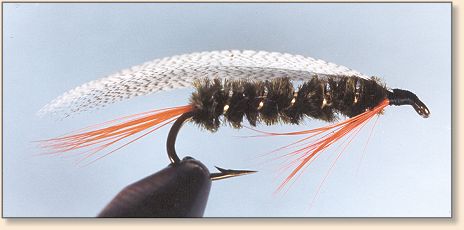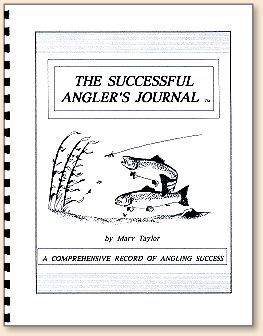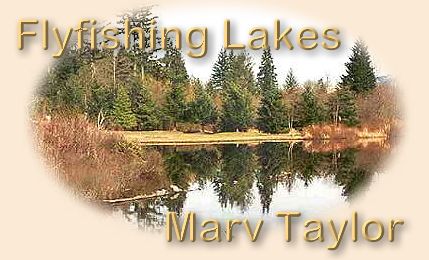|
Many anglers believe that learning to fly fish
stillwater is much easier than mastering moving
water. If we compare fishing a typical western trout
lake or reservoir, to fishing a stream like Idaho's
legendary Silver Creek, stillwater is indeed less
challenging. While lake fly fishermen don't need the
doctorate in entomology, fly tying, and presentation,
it takes to be effective at Silver Creek, there are
some rules of engagement anglers must understand if
they are to develop their stillwater skills.
My introduction to fly fishing for trout in stillwater
took place at southern Idaho's Magic Reservoir more than
50 years ago. I was on leave from the Marine Corps and
had joined three friends on a weekend camping and fishing
trip. We were bank fishing with night crawlers and salmon
eggs, and while we did catch a couple of Magic's big rainbows
the first morning, the bulk of our catch was yellow perch.
Just down the shoreline we could see a trio of fly fishermen
whooping and hollering as they caught and released trout
after trout. Although I had taken both rainbow and brook
trout in Idaho streams with flies as a boy, I had no idea
how to fly fish for trout in lakes. Since I had a small
box of dry flies with me, I rigged my fly rod and tried
to emulate the three fly rodders down the lake.
One of them watched me flailing away unsuccessfully,
walked down, introduced himself, and asked if I had
ever fished this type of water with a fly before. When
I admitted I had absolutely no idea what I was doing, my
new friend offered some tips and gave me several of the
flies he and his friends were using.
He told me the trout were feeding near the bottom of the
8-foot deep bay we were all fishing, and since I was using
a floating line, I would need to install a split shot on
my leader to get my fly deep enough. I did as he suggested
and actually caught a couple of rainbows on one of the
flies he gave me. That was my introduction to fly fishing
stillwater for trout.
Fifteen years later I walked into Ruel Stayner's Sporting
Goods Store in Twin Falls, Idaho and recognized the owner
as the helpful fly fisherman I had met at Magic Reservoir
in 1947. I had heard about Ruel Stayner from other local
fly fishermen, but I had never associated the name with
the Magic Reservoir fly fisherman who had been so helpful
so many years earlier. Over the next 30 years I was to
fish with Ruel many times (usually in float tubes),
learning something new every time we were together.

When I entered the field of outdoors journalism, it was
Ruel I quoted most often in my newspaper columns. It was
in one of my FLY OF THE WEEK newspaper features, that I
first introduced the Stayner Ducktail streamer to Idaho
fly tyers (and to a national audience when I wrote a
column for the original Fly Tyer magazine in the early
80s). While Ruel taught me to use different sinking
lines, and to experiment with various retrieves - as
well as how to tie many of his most productive patterns - the
most important thing he taught me was that fishing in
lakes, like Magic Reservoir, could be just as much of
a challenge, and just as rewarding, as fishing in nearby
Silver Creek.
Not everyone agrees. A well-known fly fishing guru once
wrote: "Random fly-fishing in stillwaters, especially
larger lakes, has seldom been popular, and is rarely
productive." While I have the greatest respect for
this author/fly tyer, who is revered by most of the
fly fishing community, he would have a difficult time
persuading dedicated western float tube/kick boat fly
fishermen that fishing their flies in stillwater,
sometimes "deep trolling" in large lakes, is uninteresting
and "rarely productive.'
A great many western stillwater fly fishermen, like the
late Ruel Stayner and Colorado's Del Canty, carved out
reputations of legendary proportions by catching large
trout in western lakes, combining Personal Floatation
Devices (PFDs) and fly rods. Just counting the float
tubes and kick boats on places like Idaho's Henry's Lake,
Montana's Clark Canyon Reservoir or Utah's Strawberry
Reservoir- when the season is in full swing- will make
a strong case for the popularity of PFDs.
All successful stillwater trout fly fishermen have one
thing in common: They understand the need to follow a
"95 by 95 rule." They strive to spend 95-percent of their
time fishing water that produces fish 95-percent of the time.
Locating high-percentage areas on smaller lakes is not
particularly difficult. But when you are fishing, for
example, a lake as large as Idaho's Henry's Lake, you
had better have some idea of where to begin.
In the case of the Big H it is fairly simple. Due to the
popularity of Henry's Lake among western fly fishermen,
you just fish where there are large numbers of boats and
PFDs. Since just about everybody these days have some
type of fish-finder on their water crafts, you can be
certain there are fish where there are large numbers
of fishermen.
KEEP RECORDS
There are a number of things a fly fisherman can do to
improve his success rate in stillwater. Like a well-run
business, being a really successful stillwater fly
fisherman begins with record-keeping. If an angler
keeps a fishing journal, he should routinely consult
his records and plan his trips to be on the water at
the (historically) most productive times.

I've kept a fishing diary for nearly 50 years. My records
will tell me when to plan a spring bluegill trip when the
big bulls are most apt to be guarding nests; I can
schedule a trip to my favorite high desert trout
reservoir when the damsels are hatching; and I can
program my vacation around the red ant hatch at my
favorite central Idaho alpine lake.
On a fishing trip, I record a great deal of data:
Where I fished and who I fished with; the most productive
hours; air and water temperatures; whether the barometer
was rising or falling; phase of the moon; identification
of insects that hatched and fly patterns that caught
fish; stomach contents of any fish I use a stomach pump
on; maps of areas I fished; how many other fishermen
were on the lake, and how they fared; and any other
information that might be useful in the future.

Of all of the records I keep, water temperature may
be the most important. Aquatic insects hatch, for
example, when water temperatures are in a specific
range. If we take water temperatures on a particular
lake when the callibaetis mayflies are hatching, we
will know when to fish the lake with our emerger and
adult mayfly patterns. Damsels hatch when the water
temperatures reach a certain level, and fishing can
improve dramatically.
There are other benefits in knowing water temperatures
on a lake. On two of my favorite central Idaho trout
reservoirs I've discovered underwater springs, by
taking water temperatures, that attract fish when
the lakes begin to warm during mid-summer. I also
catch fish in these "cold spots" in the spring and
again in the fall because the water in that area
will actually be a few degrees warmer than the
surrounding water. Much like the tail-water below
dams, these springs remain a constant temperature
year-around.
Trout anglers should know that the ideal temperature
for rainbow trout, for example, is from 55-degrees
to 70-degrees. If the water is colder than 50-degrees,
or warmer than 75-degrees, fishing can be tough; and
in the case of temperatures over 75-degrees, the angler
should probably avoid fishing because of possible stress
to fish.
DO RESEARCH
If the angler is fishing a lake or pond for the first
time (and hasn't hired a guide), he or she should stop
by a local fly fishing shop and ask about the mayfly,
caddisfly, and chironomid hatches on the lake he is
planning to fish. He should find out if scud, snail,
and forage fish are present in good numbers. He should
ask to see the top five or six local fly patterns for
the lake and if he doesn't have similar patterns in
his fly boxes, he should buy (or tie) the recommended
patterns in the sizes the local pro recommends.
While fly shop personnel might not be willing to give
away their favorite fishing holes to a stranger (who
doesn't hire one of their guides), the newcomer should
try and find out which general area he should begin
fishing. One of my fishing friends doesn't ask locals
"where" he should begin fishing; he asks them about
specific areas he should avoid. He says he rarely has
difficulty obtaining this type of information, and
knowing which areas "not" to fish can save a full
day of scouting on some of the larger lakes.
My friend also asks the names of two or three of the
"top guns" for the lake he is going to fish, and makes
some phone calls. I was with my friend in Reno some
years ago, when he called one of the local Pyramid
Lake experts. We not only got some great information
on how and where to fish, but the local pro invited
us to stay with him, and fished with us on the weekend.
A few years later he was featured in a magazine article
as one of top Pyramid Lake fly fishermen. We learned
more in two days on the water with this expert than
we would have learned in half a dozen "unsupervised" trips.
The angler should find out if the lake produces best
in the morning, afternoon, or evening. Many fly
fishermen mistakenly assume fishing will always be
more productive at dawn or at dusk. Many of the trout
lakes I fish are "midday" bodies of water, and while
the fishing may be fairly good early in the morning
and late in the evening (usually for short periods
of time), the most productive fly fishing will often
occur at midday.
FISH THE EDGES
Gamefish in lakes and ponds are attracted to "edges."
Edges of weed-beds, points of land that forms
structure-ridges, and shoals. Another common edge
is the old creek channel usually found at the upper
end of man-made reservoirs. Since this end of a
typical reservoir is usually somewhat shallow, there
are often large weed beds lining the old creek channel.
One of my favorite examples of this type of trout
habitat is found at northern Nevada's Sheep Creek
Reservoir, on the Duck Valley Indian Reservation.
The old creek channel meanders about half a mile
down into the reservoir. It is easy to find because
the weed-beds do not develop in the channel because
of its rocky bottom.
I use two basic strategies in this type of habitat.
I either position my PFD a few feet back in the weeds
and cast to the weed-beds on the opposite side of
the channel; or I work my PFD along the edge of the
channel and fish my flies parallel with the weed beds.
Here and there I will find deeper spots in the channel
that seem to attract large numbers of trout. These
spots were probably pools in the creek before it was
flooded. I once spent two hours photographing Ruel
Stayner catching 8 or 10 nice rainbows from one from
one of these "honey holes" (mentioned earlier in this
article). I went back 10 years later, searched for
and found Ruel's hot spot, and hooked another 8 or 10
fish from the exact same casting station that Ruel
had used earlier. I probed the channel with my
depth-finder and found there was indeed a 15- by
15-foot hole, right where Ruel and I had caught fish.
Not all anglers view weed-beds with a positive mental
attitude. Several years ago I talked with another
fly fisherman at northern Montana's Mission Lake.
He was vehement in his disgust with the lake's
massive weed-beds.
"Wouldn't it be great," he argued, "if these (blankety
blank) weed beds would just die off?"
When I pointed out that we might then be fishing over
mostly two pound trout, instead of the 3- to 10-pounders
we had been hooking, he told me he would rather catch
2-pounders in open water than 10-pounders in the weeds.
He said he had been losing too many (blankety blank)
big fish to the kelp.
I was speechless (for one of the few times in my life).
As I tubed away, I hooked another heavy rainbow that
took me 50-feet into my backing before breaking off
in a heavy weed-bed with a wild, head shaking,
three-foot high leap.
"See what I mean?" my antagonist shouted with misplaced glee. ~ Marv
About Marv
The Successful Angler's Journal, shown
in this article, along with Float-Tubing
The West, More Fragments of the Puzzle, (Volume I) and More
Fragments of the Puzzle, (Volume II) are all available from
Marv. You can reach Marv by email at
marvtroutman@juno.com or by phone: 208-322-5760.
|





